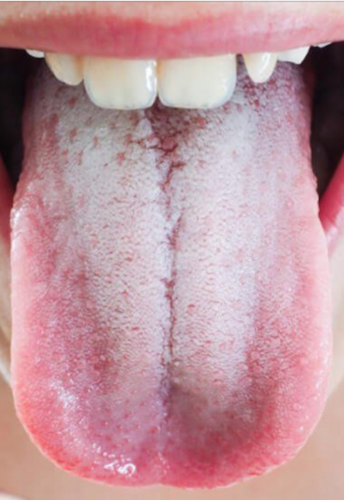Good morning readers
Today let’s discuss a bit about Tongue Evaluation. If you have any doubts about this evaluation type, I hope this text will assist you.
Today’s evaluation will be regarding the tongue shown in the post illustration.
Everytime that we are going to evaluate a tongue, we must first observe the following criteria:
- Tongue’s Color
- Color and Thickness of tongue’s Coating
- Tongue’s Shape
Let’s analyse the sequence below:
– Tongue’s Color:
It’s the color that shows up on the tongue’s body, under the coating. It must be a vivid red and even through all extension. Note that this tongue has a darker red tone on it’s tip, against the rest of its body, besides that, we can also observe, in this region, small petechiae, which basically are little dark red “balls”. Both the darker red tone as the petechiae are considered Heat symptoms in Chinese Medicine. As both are located on the tongue’s tip, ruled by the Heart, that means the patient itself suffers from Heart Heat.
Are Heat Heart symptoms: mental agitation, insomnia, light sleep, palpitations, verbiage, etc…
– Color and Coating thickness:
The coating must be translucent, namely, it’s necessary that we are able to see the tongue’s body that’s under the coating, besides it needs to be thin and well distributed through the root till the tip.
In the image we can see that the coating is white, thick and is present only in the root and in the middle of the tongue.
The white coating indicates that there is coldness on the inside. When it shows up in the middle of the tongue, it means this coldness is focused on the Middle Burner, particularly, in the Stomach and in the Spleen. On the tongue’s root, there is an indicator that reveals that there is also coldness on the Lower Burner, particularly in the Kidney
This coldness, since it’s affecting internal organs, it’s due to a Yang Deficiency in the Spleen and Kidney (Yang energy represents the heat and once it’s in Deficiency, all left to the body is the cold energy, Yin).
Are symptoms of Yang Deficiency, creating Inner Cold in the Spleen and in the Kidney: coldness sensation, slow digestion, lack of appetite, desire to consume hot aliments and beverages, diarrhea or loose stools, cold knees and lumbar, body edema or profuse urine, sleepingness, etc..
– Tongue’s Shape
The tongue that illustrates this text does not have any alterations on its shape. It’s roundy, with no tooth marks on the sides, no fissures or a bifurcated tip.
This way, we can say that this patient suffers from Heart Heat and Spleen and Kidney Coldness caused by its Yang energy deficiencies.
The treatment is based on the reduction of Heart Heat and Toning Spleen and Kidneys Yang.
Treatment Suggestion:
- In order to sedate the Heart Heat: HT7 e HT5.
- In order to Tone Spleen Yang: SP3, SP9 – moxabustion might be used to remove coldness and humidity.
- In order to Tone Kidney Yang: KI7, CV4 – moxabustion might be used to remove coldness and humidity.
This way, I want the reader to reflect about the points choice. When we identify which syndrome the patient is suffering from, we should not choose the points based on the symptoms they present, but according to their energetic action, which fixes the patient’s imbalances.
The energetic actions of the points always justify the symptoms the point is able to heal! Think about it!
Hope I had helped! If you enjoyed it, consider leaving a comment on instagram (@facilitandoacupuntura) !
A very tight hug!
Profa. Fernanda Mara